
Corcorax melanorhamphos
SUBFAMILY
Corcoracinae
TAXONOMY
Corcorax melanorhamphos Vieillot, 1817. Monotypic.
OTHER COMMON NAMES
English: Black jay, black magpie; French: Corbicrave leucoptиre;
German: Drosselkrдhe; Spanish: Chova de Alas Blancas.
PHYSICAL CHARACTERISTICS
Choughs are large sooty black birds with long, curved, black
bills, long tails, and large white wing patches that are visible in
flight. They have red eyes that become brighter during displays
when wings and tail are fanned out and moved up and down.
Males and females have similar plumage. Juveniles are fluffier,
with brown eyes that change to red over four years. Adults are
17–19 in (43–47 cm) long and weigh 11–12 oz (320–350 g).
DISTRIBUTION
Choughs live in southeastern Australia.
HABITAT
Open woodland with leaf litter and not much understory.
BEHAVIOR
Choughs live in groups of about four to 20 birds. Groups usually
consist of a breeding pair with offspring from previous
years, though small groups of unrelated birds may come together.
Groups sometimes even kidnap juveniles from other
groups—the bigger the group the better! Chough are excitable
and noisy in their interactions within the group, and the whole
group joins in to dive-bomb intruders.
FEEDING ECOLOGY AND DIET
Choughs forage together on the ground, tossing aside leaf litter,
probing with their bills and sifting through the soil for insects,
worms and other ground-dwelling prey. Rob Heinsohn
found that choughs take an unusually long time to learn to forage:
juveniles remain dependent on parental care for longer
than most other birds, and their foraging skills continue improving
over the first four years of life.
REPRODUCTIVE BIOLOGY
Choughs are unable to raise young successfully unless they
have help; large groups communally raise all chicks in the
brood, while small groups only manage one or two. This cooperative
breeding is primarily due to foraging constraints because
small groups raise more chicks if they are given
supplementary food. For young choughs, whose own foraging
skills are still developing, helping at the communal nest is
costly. Chris Boland and co-workers found that if no other
group members are around when they deliver food to the nest,
young birds are likely to swallow it themselves instead of feeding
it to the chicks.
CONSERVATION STATUS
Not threatened.
SIGNIFICANCE TO HUMANS
None known.
Photo Gallery of - White-winged chough




 Animalia Life
Animalia Life